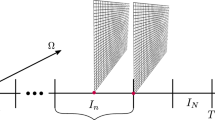Abstract
Based on a fully overlapping domain decomposition technique, a parallel stabilized equal-order finite element method for the steady Stokes equations is presented and studied. In this method, each processor computes a local stabilized finite element solution in its own subdomain by solving a global problem on a global mesh that is locally refined around its subdomain, where the lowest equal-order finite element pairs (continuous piecewise linear, bilinear or trilinear velocity and pressure) are used for the finite element discretization and a pressure-projection-based stabilization method is employed to circumvent the discrete inf–sup condition that is invalid for the used finite element pairs. The parallel stabilized method is unconditionally stable, free of parameter and calculation of derivatives, and is easy to implement based on an existing sequential solver. Optimal error estimates are obtained by the theoretical tool of local a priori error estimates for finite element solutions. Numerical results are also given to verify the theoretical predictions and illustrate the effectiveness of the method.


Similar content being viewed by others
References
Bank RE, Holst M (2000) A new paradigm for parallel adaptive meshing algorithms. SIAM J Sci Comput 22:1411–1443
Bank RE, Jimack PK (2001) A new parallel domain decomposition method for the adaptive finite element solution of elliptic partial differential equations. Concurr Comput Pract Expert 13:327–350
Barth T, Bochev P, Gunzburger M, Shahid J (2004) A taxonomy of consistently stabilized finite element methods for the Stokes problem. SIAM J Sci Comput 25(5):1585–1607
Becker R, Braack M (2001) A finite element pressure gradient stabilization for the Stokes equations based on local projections. Calcolo 38(4):173–199
Bochev PB, Dohrmann CR, Gunzburger MD (2006) Stabilization of low-order mixed finite elements for the Stokes equations. SIAM J Numer Anal 44(1):82–101
Bochev P, Gunzburger M (2004) An absolutely stable pressure-Poisson stabilized finite element method for the Stokes equations. SIAM J Numer Anal 42:1189–1207
Brezzi F, Fortin M (2001) A minimal stabilisation procedure for mixed finite element methods. Numer Math 89:457–491
Codina R, Blasco J (1997) A finite element formulation for the Stokes problem allowing equal velocity-pressure interpolation. Comput Methods Appl Mech Eng 143(3–4):373–391
Codina R, Blasco J (2000) Analysis of a pressure-stabilized finite element approximation of the stationary Navier–Stokes equations. Numer Math 87(1):59–81
Douglas J, Wang J (1989) An absolutely stabilized finite element method for the Stokes problem. Math Comput 52:495–508
Franca L, Hughes T (1993) Convergence analyses of Galerkin-least-squares methods for symmetric advective–diffusive forms of the Stokes and incompressible Navier–Stokes equations. Comput Methods Appl Mech Eng 105(2):285–298
Ganesan S, Matthies G, Tobiska L (2008) Local projection stabilization of equal order interpolation of the Stokes problem. Math Comput 77(264):2039–2060
He YN, Li J (2008) A stabilized finite element method based on local polynomial pressure projection for the stationary Navier–Stokes equations. Appl Numer Math 58:1503–1514
He YN, Xu JC, Zhou AH, Li J (2008) Local and parallel finite element algorithms for the Stokes problem. Numer Math 109(3):415–434
He YN, Xu JC, Zhou AH (2006) Local and parallel finite element algorithms for the Navier–Stokes problem. J Comput Math 24(3):227–238
Hecht F (2012) New development in FreeFem++. J Numer Math 20(3–4):251–265
Hughes T, Franca L, Balestra M (1986) A new finite element formulation for computational fluid dynamics: V. Circumventing the Babu\(\breve{s}\)ka–Brezzi condition: a stable Petrov–Galerkin formulation of the Stokes problem accommodating equal-order interpolations. Comput Methods Appl Mech Eng 59(1):85–99
Hughes TJR, Liu W, Brooks A (1979) Finite element analysis for incompressible viscous flows by penalty function formulation. J Comput Phys 30:1–60
Li J, He YN (2008) A stabilized finite element method based on two local Gauss integrations for the Stokes equations. J Comput Appl Math 214:58–65
Mitchell WF (2004) Parallel adaptive multilevel methods with full domain partitions. Appl Numer Anal Comput Math 1(1–2):36–48
Shang YQ (2013) A parallel subgrid stabilized finite element method based on fully overlapping domain decomposition for the Navier–Stokes equations. J Math Anal Appl 403:667–679
Shang YQ (2013) Parallel defect-correction algorithms based on finite element discretization for the Navier–Stokes equations. Comput Fluids 79:200–212
Shang YQ, He YN (2010) Parallel finite element algorithm based on full domain partition for stationary Stokes equations. Appl Math Mech Engl Ed 31(5):643–650
Shang YQ, He YN (2010) Parallel iterative finite element algorithms based on full domain partition for the stationary Navier–Stokes equations. Appl Numer Math 60(7):719–737
Vey S, Voigt A (2007) Adaptive full domain covering meshes for parallel finite element computations. Computing 81(1):53–75
Xu JC, Zhou AH (2000) Local and parallel finite element algorithms based on two-grid discretizations. Math Comput 69:881–909
Xu JC, Zhou AH (2001) Local and parallel finite element algorithms based on two-grid discretizations for nonlinear problems. Adv Comput Math 14:293–327
Author information
Authors and Affiliations
Corresponding author
Additional information
Publisher's Note
Springer Nature remains neutral with regard to jurisdictional claims in published maps and institutional affiliations.
This work was supported by the Natural Science Foundation of China (No. 11361016), the Basic and Frontier Explore Program of Chongqing Municipality, China (Nos. cstc2016jcyjA0348, cstc2018jcyjAX0305), and Fundamental Research Funds for the Central Universities (No. XDJK2018B032).
Rights and permissions
About this article
Cite this article
Shang, Y. A parallel stabilized finite element method based on the lowest equal-order elements for incompressible flows. Computing 102, 65–81 (2020). https://doi.org/10.1007/s00607-019-00729-0
Received:
Accepted:
Published:
Issue Date:
DOI: https://doi.org/10.1007/s00607-019-00729-0
Keywords
- Incompressible flow
- Stokes equations
- Finite element
- Stabilized method
- Parallel algorithm
- Domain decomposition



